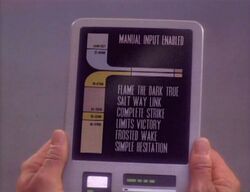PADD

"PADD" is an acronym for Personal Access Display Device, a hand-held computer interface, used as early as the 22nd century and well into the 24th century.
PADDs were used by such space-faring organizations as Earth Starfleet and the later Federation Starfleet, as well as by the Andorian Imperial Guard, Bajoran Militia, Cardassian Union, Klingon Empire, Romulan Star Empire, and Vulcan High Command. They were common to cultures even as distant as the Delta Quadrant.
General Specifications[edit]
Consisting of a large touchscreen display and minimalistic manual interface or control panel (generally only one or two buttons), the typical PADD is used for a variety of functions including logging manifests, compiling duty rosters or diagnostic reports, entering personal data, and/or accessing library computer systems.
Varying in size, shape and specification, PADDs are often distinguished by the species of their manufacturer or user, Earth and Federation Starfleet PADDs generally flat and rectangular in shape, Klingon and Cardassian PADDs often more angular.
- The internal circuitry of the Starfleet issue PADD circa 2360s was revealed only once, in the TNG episode "A Fistful of Datas". While the Star Trek: Deep Space Nine Technical Manual indicated isolinear internal components, the aforementioned episode portrayed a PADD utilizing printed circuit boards just like present-day computers, and only partially made of isolinear circuits
The Star Trek: The Next Generation Technical Manual states that Starfleet PADDs are powered by sarium krellide power cells, and have an outer casing of boronite whisker epoxy, which would allow the PADD to sustain a 35-meter drop without damage.
One of the most often used devices employed by personnel serving in the Federation Starfleet, PADDs were common aboard Federation starships, space stations, and planetary facilities during the 23rd and 24th centuries.
First appearing as late as 2266 aboard such starship types as the Constitution-class vessel, PADDs of the 2260s were large, wedge-shaped devices, operated almost exclusively through the use of a stylus. These data PADDs were often carried by yeomen aboard starships, but appeared in other locations including Starfleet's Starbase 11. (TOS: "The Man Trap", "The Menagerie, Part I", "The Menagerie, Part II"; DS9: "Trials and Tribble-ations")
While it has never been explicitly referred to as a PADD in any of the Star Trek series or films, the Star Trek Encyclopedia uses this device, as well as the clear, PADD-like device carried by Chekov in Star Trek VI: The Undiscovered Country to illustrate its small section on PADDs. Before the first appearance of the TOS PADD in the first aired episode, a clipboard was used for the same task in "The Cage". Several TOS novels use the term "data slate". By 2364, PADDs had taken on a smaller profile and, while some models would include one, the stylus was replaced by simple, touch-sensitive controls, generally located beneath a small, square-shaped display screen. Generally small and light-weight, the PADDs of the 2360s and 2370s were basically rectangular in shape, but varied in size, proportion, and even color – ranging from gray and muted blue colors, to red. Some PADDs, like the one used by Dr. Lewis Zimmerman aboard Jupiter Station in 2376, were translucent. (TNG: "Encounter at Farpoint"; DS9: "Emissary"; VOY: "Caretaker", "Life Line", et al.) When struck with enough force, the screen of a PADD could be shattered resulting in shards sharp enough to cut human skin. (DS9: "Statistical Probabilities")
While the common function of these Federation PADDs was most often straight forward data entry or data retrieval, some PADDs were capable of more artistic tasks. Some PADDs, often larger in size than most of their counterparts, were used to draw up schematics or to create composite images or artwork. PADDs were also capable of predictive text functions, allowing users to enter a small amount of data to achieve full words or even sentences. In addition, a stylus could be used for text entry. (DS9: "Babel", "The House of Quark", "The Muse", "Image in the Sand")